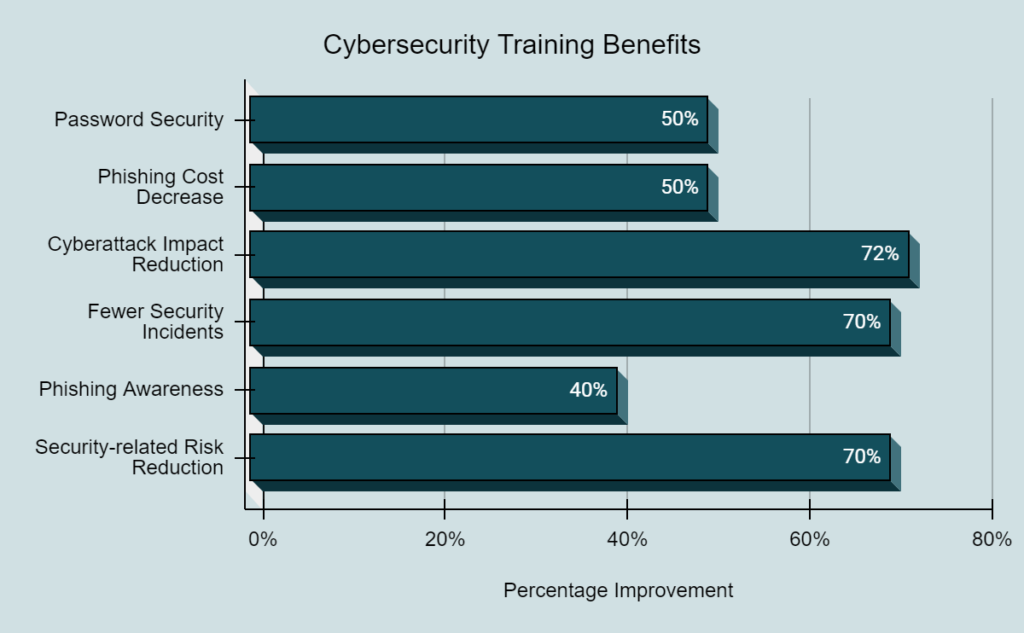Cybersecurity training or information security training, aka infosec training, might not be a favorite topic of discussion among your L&D team members. But you can face serious consequences if you do not give enough importance to making your employees aware of cybersecurity issues. Why?
Knowledge of cybersecurity and information technology is inevitable since it serves as the backbone for preventing a cyber breach or attack. After all, one cannot report a security breach when one does not recognise it. And one of the significant reasons for cyber threats is human errors. So, now, let us understand in detail why an efficient cybersecurity training or infosec training program is necessary.
Table of Contents
Why Cybersecurity Training for the Workforce is More Important Than Ever?

Cybersecurity training offers a gamut of benefits:

Identification of Cyber Threats
Cybersecurity threats come in various types, clad in multiple disguises and ready to go! A cyber threat must be identified, reported, and addressed. If you see something, you need to report it instantly. Cybersecurity seems like common knowledge, but human error accounts for a huge chunk of successful cyber-attacks.
With that information, managers should keep in mind that hackers don’t just enter via the IT department. They go after vulnerabilities. That’s why infosec training to demonstrate cybersecurity skills and understanding are the responsibility of every role in the company.
Cybersecurity Awareness
When employers make cybersecurity or infosec training a priority, they are helping to prevent significant losses within a company. However, awareness training rarely addresses the skill and application of that knowledge. Changing risky employee behavior will help quell a cyber-attack and is critical for businesses to understand.
It’s not enough to be knowledgeable about security but to implement a career-long training strategy that will help to eradicate cybercrime. There are constantly new threats to cyber safety, so ongoing training is essential and should be a part of the overall infosec training process from the very beginning.
What Should Be Your Cybersecurity Training Game Plan?

Some think small businesses can avoid significant hacks and breaches, but that is untrue. Since human error is the biggest problem we face, that means that everyone is at risk.
To drive home the point on the urgency of cybersecurity, you must keep the employees abreast of all the latest data: a weekly bulletin highlighting what’s new in cybersecurity and safety is an effective measure in spreading awareness and targeting what they need to do.
The Basic Framework of Cybersecurity Training
All training programs are unique, but the most significant difference is their efficacy and implementation in the workplace. A business should focus on cybersecurity training or infosec training in general and the right cybersecurity dangers to look for, such as insider threats, ransomware, etc.
This type of infosec training should be mandatory for all employees at every level. Essentially anyone using a computer should know how to identify phishing schemes and social engineering attacks. These things may go overlooked and create severe problems if they are not easily identifiable.
These attacks can happen via email or telephone, so that’s a base you should cover. Cover secure browsing practices during training. All employees should be able to identify and avoid suspicious links and evade hacking attempts since phishing attempts are on the rise.
In the case of remote work (which has been rising for months due to the COVID-19 pandemic), you should acknowledge the dangers of public Wi-Fi. Cover the possibility of leaked passwords or other data and how to prevent the same in your infosec training.
So let’s focus on what employees should know and what they should do. For the training to be practical, “live fire” practice attacks should be conducted to enable employees to handle this type of breach.
A live-fire exercise in an infosec training session simulates the real thing. Like a fire drill, this implementation will mimic a true-to-life scenario and help prepare employees to behave and react when an actual cyber-attack occurs.

Here is a suggested list of topics you will need to cover for comprehensive Cybersecurity Training or Infosec Training for your workplace:
- Information Security
- What should not be shared online
- Identity theft
- Protect yourself & your employer against identity theft
- Authentication and passwords
- Internet Security
- Configuring web-browser security settings
- Secure Backups
- Encrypting
- Sandboxing
- Scanning Viruses Using Online Tools
- Secure Online Shopping
- Securing your Emails
- Antiviruses
- Attacks
- DNS attacks
- HTTP attacks
- Cookie hijacking attacks
- Session hijacking attacks
- Intro to Malware, Ransomware and Spyware
- Understanding the S in HTTPS Access
- Recognizing Sophisticated Spear Phishing Scams
- Exploiting Human Psychology with Social Engineering
- Securing Desktop Apps that Access Social Networks
- Mobile security
- Understanding Mobile App Security
- Using Multi-factor Authentication
- Understanding the Dangers of Metadata
- Risks of Location-Based Social Networks
- How Hackers Use Geolocation Tracking Maliciously
- How to Safely Access Public Wi-Fi
- Mobile cybersecurity and hardware threats
- Hacked Chargers: The Latest Cybersecurity Risk
- Safely Disposing of Mobile Digital Storage Devices
- Cybersecurity and work from home
- Cybersecurity for BYOD
Engagement During Cybersecurity Training
Like any other training, cybersecurity training or infosec training is only effective when employees are present and engaged for its duration. If you (and by extension, your employees) view cybersecurity training as a box, you tick once and forget, and it’s as if you didn’t deliver said training at all.
Create (or buy) engaging courses: First and foremost: your infosec training courses should be engaging, not boring.
Read More: Design Top-Notch Workplace Learning Content by Overcoming These 5 Major Roadblocks
Use more real-life examples: You should understand how to present complex subject matters, like password safety, in a way that makes sense and feels relevant to your employees’ daily lives.

Avoid technical, confusing language: Even when your training covers complex issues like the GDPR, you can still make sure you’re using a language that would be easily understandable by a 15-year-old. That way, employees won’t feel alienated by the jargon.
Offer micro-learning sessions regularly: Cybersecurity training or infosec training for employees should not happen once — and then promptly forgotten about. Microlearning is excellent for engagement and makes it possible for employees to study from their mobile phones.
Ad: PlayAblo’s Enterprise-Grade Micro-Learning platform is built for millennial learners. Micro-Learning, along with assessments and gamification features, ensures learning outcome measurement along with sustained engagement.
Find out more and request a custom demo!
Add gamification elements to your infosec training. From fun quizzes to scoreboards and interactive features that use social and informal training, gamification ensures that learners are more likely to stay focused till the end of the course. By involving fun elements — even if it’s something as simple as a badge they can share with their coworkers.
Read More: Impact of Gamification in Corporate Learning
Make sure you cover all learning styles: Some people learn better by reading; others by seeing, listening or doing. Animated, voice-over videos that include captions, combined with more practical, hands-on tasks, make it easier for all different types of learners to stay engaged during cybersecurity training.
Create follow-up infosec training to reinforce learning: Even if your employees have retained the information from their training at first, they may slip back to their old, bad habits after a while. It would be best to evaluate employees frequently and always have follow-up training at hand for when people need a refresher.
Use certificates and prizes as incentives: Most people are results-driven. Offering a prize or a certificate once they complete their infosec training can work as an extra incentive for them to remain engaged throughout its duration.
Cybersecurity training should be for humans, not machines: Just because it’s about devices, it doesn’t mean infosec training for employees should feel like it was created for machines.
Conclusion
If you deliver cybersecurity training or infosec training without making it engaging to real humans, you throw away more than just the money you spent on creating it. You also risk hurting your brand reputation and incurring everything from cyberattacks to compliance fines.
Ad: PlayAblo’s Enterprise-Grade Micro-Learning platform is built for millennial learners. Micro-Learning, along with assessments and gamification features, ensures learning outcome measurement along with sustained engagement.
Find out more and request a custom demo!







Comments are closed, but trackbacks and pingbacks are open.